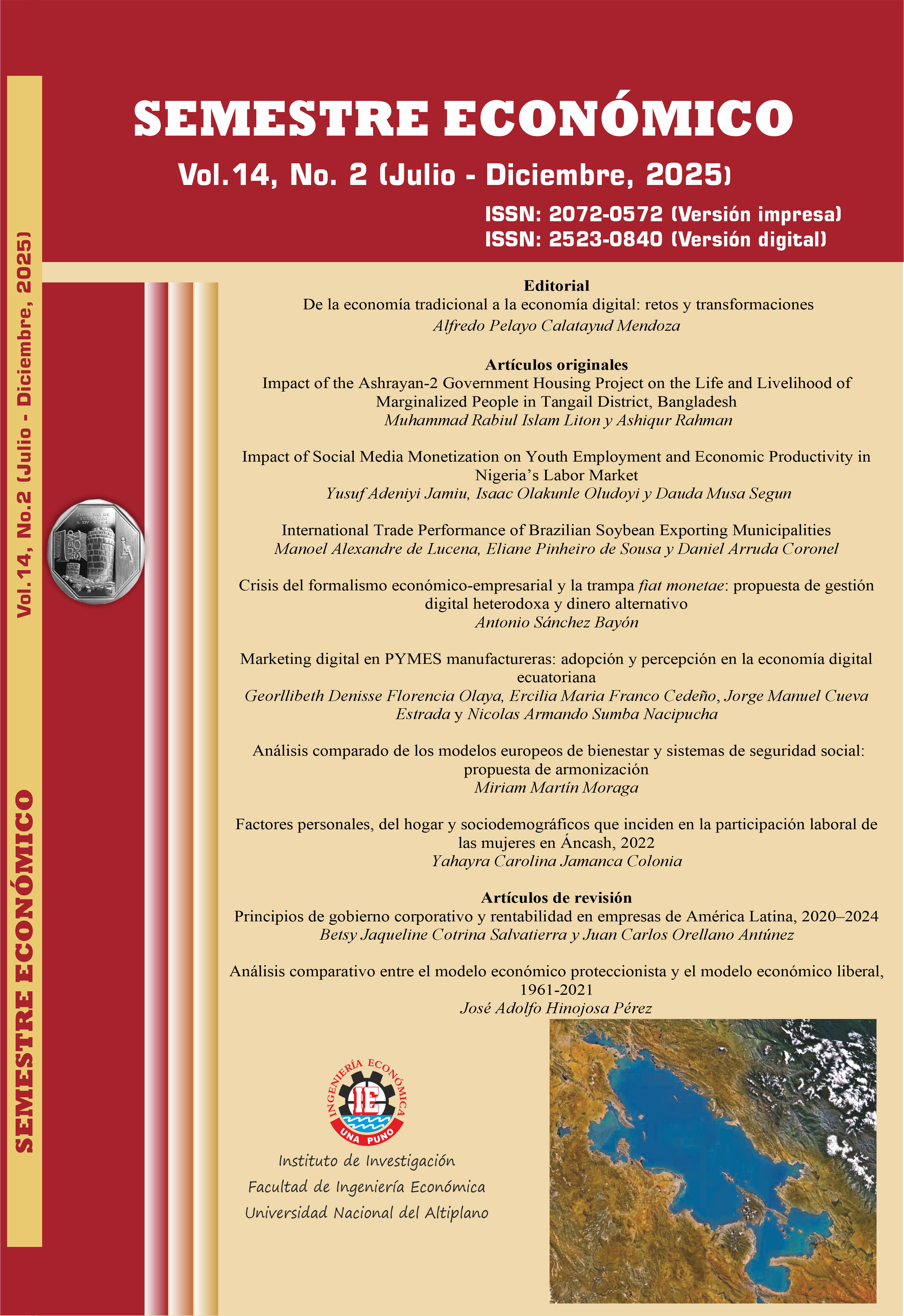Impact of the Ashrayan-2 Government-Housing Project on Life and Livelihood of Marginal People in Tangail District of Bangladesh
DOI:
https://doi.org/10.26867/se.2025.v14i2.187Keywords:
Impact, Ashrayan-2 project, Livelihood, Marginal people, BangladeshAbstract
Bangladesh is one of the most climate-vulnerable countries in the world. She suffers from regular natural hazards, viz., floods, storm surges, droughts, and tropical cyclones. These hazards lead to the loss and destruction of housing, land, and property that resulted in the loss of the livelihoods of the affected people and hence, widespread displacement across the country. For these vulnerable people, the government takes various programs simultaneously to meet the basic needs of these marginalized people of the society. In Mujib Borsho, the Bangladesh government introduced a housing program, namely the Ashrayan 2 project, to provide houses to the homeless and landless people in the quickest time. In its first phase (reported on 23 January 2021), a total of 69,904 families have been given houses along with ownership rights. In the second phase (reported on June 20, 2021), more than 53,000 families were provided houses in a similar fashion. Therefore, the study aims to examine the impact of the housing project on the livelihood of the beneficiary households. To achieve these objectives, the study uses the livelihood platform approach of the SLA framework for calculating the livelihood standard of the beneficiary people. To pursue the study, required data were collected from 145 beneficiary households from 8 project intervention areas located in Sadar Upazila of Tangail District. From the analysis of the data, the study found that the project affects beneficiaries’ livelihoods positively, albeit to a small extent. Various income-generating programs and house-related facilities may contribute to ensuring better livelihood.
Metrics
References
Barkat, A., Zaman, S. Uz, & Raihan, S. (2000). Khas Land: A Study on Existing Law and Practice. System, November, pp. 1–13.
Barkat, A. (2004). Deprivation Mediated through Khas-Land: Some Case Studies. In A. Barkat & S. uz Zaman (Eds.), Political Economy of Khas Land in Bangladesh (2nd ed., pp. 160 – 174). Dhaka: Association for Land Reform and Development (ALRD), Dhaka, Bangladesh.
Barkat, A., Zaman, S. uz, & Raihan, S. (2001). Political Economy of Khas Land in Bangladesh. Dhaka, Bangladesh: Association for Land Reform and Development (ALRD), Dhaka, Bangladesh.
Barua, P. and Rahman, S.H. (2018) ‘The role of traditional ecological knowledge for south eastern island community of Bangladesh perspective for disaster management’, IUP Journal of Knowledge Management, Vol.18, No. 1, pp.35–50.
Barua, P; Rahman, S.H. and Molla, M.H. (2019). Impact of river erosion on livelihood and coping strategies of displaced people in South-Eastern Bangladesh, Int. J. Migration and Residential Mobility, Vol. 2, No. 1, pp. 34-55.
Barua, P., Rahman, S.H. and Molla, M.H. (2017). Sustainable adaptation in responses of climate displacement issues in the South Eastern Island communities of Bangladesh, International Journal of Climate Change Strategies and Management, Vol. 15, No. 1, pp.120 140.
Bryden, J. and Charles G. (2007). Community-based land reform: Lessons from Scotland. Land Use Policy, Vol. 24, pp. 24–34.
Chowdhury, M.O. and Chowdhury, F. (2021). Factors Affecting the Income of Coastal Fishermen: Evidence from Barguna District of Bangladesh, Journal of Business and Technology (Dhaka), Vol. 14, No. 1&2, PP. 91- 107.
Das, D., Mallick, B., & Vogt, J. (2012). Social Process Analysis in Poverty Alleviation Program: A Study of Khas-Land Distribution in Rural Bangladesh. Journal of Bangladesh Institute of Planners (BIP), Vol. 5, PP. 25–36.
Das, D. (2010). Analyse der Verteilung des Khas-Landes in ländlichen Bangladesch - Das Beispiel des Dorfes Shovna. Karlsruhe Institute of Technology (KIT).
Ding, C. (2007). Policy and praxis of land acquisition in China. Land Use Policy, Vol. 24, No. 1, pp. 1–13. Available at: https://doi.org/https://doi.org/10.1016/j.landusepol.2005.09.002
Fujita, Y., Kawaguchi, M. and Hai, T.P. (2000) ‘A conceptual model for erosion processes of high river bank’, Annual Journal of Hydraulic Engineering, Vol. 44, No. 6, pp.753–758.
Hossain, Monzur. 2015. Improving Land Administration and Management in Bangladesh. Background paper for the Preparation of the Seventh Five Year Plan.
Availabile online: http://www.plancomm.gov.bd/wp-content/uploads/2015/02/4_Improving-Land-Administration-and-Mangement.pdf (accessed on 15 June 2017).
Islam, M.F. and Rashid, A.N.M.B. (2011). Riverbank Erosion Displaces in Bangladesh: Need for Institutional Response and Policy Intervention, Bangladesh Journal of Bioethics, Vol. 2, No. 2, pp. 4-19.
Kadir, M.N. and Naher, T. (2023). Review of Riverbank Erosion and Deposition Phenomena in Bangladesh, International Journal of Research Publication and Reviews, Vol 4, No. 11, pp 766-775.
Mallick, B., & Sultana, Z. (2017). Livelihood after relocation-evidences of Gucchagram project in Bangladesh. Social Sciences, Vol. 6, No. 3.
Available at: https://doi.org/10.3390/socsci6030076
Miah, M.T.H. (2021), Ashrayan: Poverty alleviation and sustainable development, Prime Minister’s Office, Bangladesh, 20th June 2021.
Momen, M. A. (1996). Land Reform and Landless in Bangladesh. University of East London.
Montle, B.P. and Teweldemedhin, M.Y. (2014) ‘Assessment of farmers’ perceptions and the economic impact of climate change in Namibia: case study on small-scale irrigation farmers (SSIFs) of Ndonga Linena irrigation project’, Journal of Development and Agriculture Economics, Vol. 6, No. 2, pp.443–454.
Nguyen; Thanh, T.; Lam Do,T.; Bühler,D; Hartje, R. and Grote,U. (2015). Rural livelihoods and environmental resource dependence in Cambodia. Ecological Economics 120: 282–95.
Niroula, G. S., & Thapa, G. B. (2005). Impacts and causes of land fragmentation, and lessons learned from land consolidation in South Asia. Land Use Policy, Vol. 22, No. 4, pp. 358–372. Available at: https://doi.org/https://doi.org/ 10.1016/j.landusepol.2004.10.001
Oldenburg, P. (1990). Land consolidation as land reform, in India. World Development, Vol. 18, No. 2, pp. 183–195.
Available at: https://doi.org/https://doi.org/10.1016/0305-750X(90)90047-2
Otsuka, K. (1991). Determinants and consequences of land reform implementation in the Philippines. Journal of Development Economics, Vol. 35, No. 2, pp. 339–355.
Available at: https://doi.org/https://doi.org/10.1016/0304-3878(91)90054-Y
Penning-Rowsell, E.C., Haigh, N., Lavery, S. and McFadden, L. (2013) ‘A threatened world city: the benefits of protecting London from the sea’, Natural Hazards, Vol. 66, No. 3, pp.1383–1404
Peters, P. E. (2009). Challenges in Land Tenure and Land Reform in Africa: Anthropological Contributions. World Development, Vol. 37, No. 8, pp. 1317–1325. Available at: https://doi.org/https://doi.org/10.1016/j.worlddev.2008.08.021
Rahman, M.M; Khan, M.R.A.; Horayra, S.M. A.; Moni, Z. R. and Molla, M.M.U. (2020). Effectiveness of Integrated Approach of Training and Micro-Credit Program for Poverty Reduction of Relocated People in Guchchhogram, international journal of business, social and scientific research, Vol. 8, No. 3, Page: 117–123.
Rahman, M.A. (2017). Resettlement of Climate Induced Displaced People in Bangladesh: Governance Perspective, IOSR Journal of Humanities and Social Science (IOSR-JHSS), Vol. 22, No. 10, pp. 07-17
Rahman, S. and Rahman M.A. (2015). Climate extreme and challenges to infrastructure in coastal cities in Bangladesh. Weather and Climate Extreme, Vol. 7, pp. 96–108.
Rudra, R. R. Sharif, M.S. and Mahi, M.M. (2022). Subsistence after resettlement: observations from Gucchagram project in Narail district, Bangladesh. Khulna University Studies, Special Issue (ICSTEM4IR), pp. 321-331. U
Special Issue ICSTEM4IR: 321-331,
Thapa, G. B., & Niroula, G. S. (2008). Alternative options of land consolidation in the mountains of Nepal: an analysis based on stakeholders’ opinions. Land Use Policy, Vol. 25, pp. 338–350.
Wannasai, N., & Shrestha, R. (2008). Role of land tenure security and farm household characteristics on land use change in the Prasae Watershed, Thailand. Land Use Policy, Vol. 25, pp. 214–224. Available at. https://doi.org/10.1016/ j.landusepol.2007.07.003
Downloads
Published
Issue
Section
License
Copyright (c) 2025 Muhammad Rabiul Islam Liton, Ashiqur Rahman

This work is licensed under a Creative Commons Attribution 4.0 International License.














